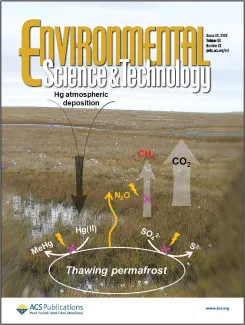Nitrous oxide strongly inhibits CH4 and MeHg formation, resulting from the complicated interplay of microbial processes in anoxic soils that ultimately determine how climate change will influence greenhouse gas formation and mercury transformation in the Arctic ecosystem.
Climate warming causes permafrost thaw that is predicted to increase methane (CH4), carbon dioxide (CO2), and toxic methylmercury (MeHg) formation—as well as nitrous oxide (N2O), another potent greenhouse gas formed during degradation of N-containing soil organic matter in the Arctic. A microcosm incubation study with Arctic tundra soil over 145 days demonstrated that 0.1 and 1 mM concentrations of N2O markedly inhibited microbial MeHg formation as well as methanogenesis and sulfate reduction, whereas such concentrations slightly promoted CO2 production. Microbial community analyses have indicated that N2O decreased the relative abundances of methanogenic archaea and microbial clades implicated in sulfate reduction and MeHg formation. Following depletion of N2O, both MeHg formation and sulfate reduction rapidly resumed, whereas CH4 production remained low, suggesting that N2O affected susceptible microbial guilds differently. Methylmercury formation strongly coincided with sulfate reduction, supporting prior reports linking sulfate-reducing bacteria (SRB) to MeHg formation in the Arctic soil. The team’s results suggest that microbial production of CH4, CO2, and MeHg is more complicated than previously thought. The research demonstrates complex biogeochemical interactions governing CH4 and MeHg formation and thus lays the foundation for future mechanistic studies for improved predictive understanding of MeHg and greenhouse gas fluxes from thawing permafrost ecosystems.
Citation: Zhang, L., Y. Yin, Y. Sun, X. Liang, D. E. Graham, E. M. Pierce, F. E. Löffler, and B. Gu. 2023. “Inhibition of methylmercury and methane formation by nitrous oxide in Arctic tundra soil microcosms.” Environ. Sci. Technol. (in press). DOI:10.1021/acs.est.2c09457.
A cover for the journal of Environmental Science & Technology, illustrating that climate warming and permafrost thaw could result in the release of the potent greenhouse gas nitrous oxide (N2O), which in turn could inhibit methanogenesis (CH4) and methylmercury (MeHg) formation. Localized micromolar up to millimolar levels of N2O could be formed via nitrification or denitrification processes during degradation of N-containing soil organic matter. The research highlights the complicated interplay of microbial processes that ultimately determine how climate change may influence greenhouse gas (CH4, CO2, N2O) formation and mercury biogeochemical transformation in the Arctic ecosystem.
For more information, please contact:
Baohua Gu
gub1@ornl.gov

